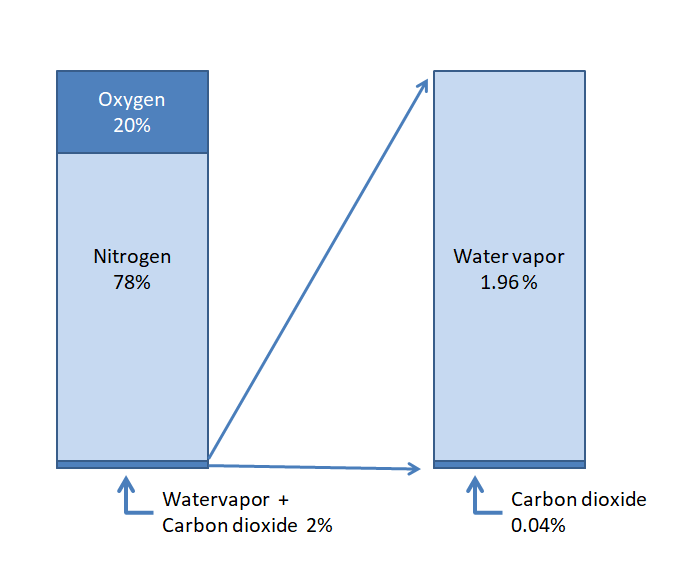By Frans van den Beemt
My own knowledge about the role of CO2 in the earth’s atmosphere is based on fundamental physics. The following is a simplified explanation of the role of CO2 gas in the earth’s atmosphere. The earth’s atmosphere is quite complex. However, an explanation of the main issues is given below, which sheds some light on the role that CO2 plays. We use some basic steps to show how CO2 participates boldly in the radiation balance, warming and cooling the earth, although in the wake of its much stronger brother, water vapor. The knowledge used here is from two recent studies; one is based on fundamental physical formulas and the other one on a widely used climate program. Also notice the study on the influence of ocean currents by Martijn van Mensvoort.

Fig 1 general composition of the atmosphere limited to the main components
The sun’s radiation heats up the earth. The earth radiates this heat outwards to space and as a result, the earth stays at a viable temperature on average. On the surface of the earth itself, we see the temperature change on an hourly, daily and seasonal basis, which we call weather. The average of weather data over 30 years is what we call the climate.
We are seeing the climate getting warmer slowly and we worry about that. Calculation models have predicted much larger changes in warming than what has been observed since the prediction date to today. The climate is extremely complex and cannot be captured in man-made models. Yet many people are convinced that the increase in the concentration of CO2 gases into the atmosphere due to human activities is the cause of global warming. Hence reducing CO2 emissions would be the solution. However, the oceans make up 70% of the earth’s surface and the amount of water vapor in the first few feet above it strongly absorbs the heat radiation that the ocean emits, and some more or less CO2 absorption has virtually no effect on it. The remaining 30% of the earth’s surface is land, above which all heat radiation, which is specific for CO2, is already absorbed in the first 10 meters at the current CO2 concentration. Variation in CO2 concentration makes no difference to the amount of heat that is absorbed. Higher up in the atmosphere– well above the clouds in the relatively warm ozone layer, CO2 gas emits heat radiation directly into space, substantially cooling the earth. When the concentration of CO2 is increased, this outward emission to space happens at higher altitudes, where the temperature is also higher due to the temperature inversion of the warm ozone layer there. This results in an even stronger rate of cooling. Then between altitudes of 2 km to 8 km, CO2 gas has some additional absorption and radiation properties, associated with colliding molecules which slightly change the amount of absorption of CO2. When the CO2 concentration is increased, the radiant effect of CO2 shifts upwards in height. Consequently, it emits less heat into space at a lower temperature. This is considered as the warming effect of CO2. But here, too, water vapor partly overlaps the radiance of CO2, and in cloudy regions, clouds cancel any effects of CO2 concentrations in these air layers between 2 km and 8 km, and any surplus heat is distributed by colliding molecules over all air molecules, water vapor and top of clouds, and eventually radiates into space. The globally measured average cloud cover ratio amounts to no less than 62% and blocks any CO2 action in its environment. Furthermore, at ground level there is strong evaporation, using up high amounts of energy. This “latent” energy in water vapor is transported up by rising air, known as convection, followed by cloud formation, releasing the latent heat to much higher altitudes, where it will be emitted to space. Obviously, every little bit of warming that would ever arise will be strongly suppressed. Then again, we have not even discussed the large heat transport of our oceans.
Consequently, doubling the current CO2 concentration will not have any measurable effect on global warming on average.
Now we will discuss the general circulation models. Initially, the models calculate the radiation field of absorption and emission of our atmosphere, grid by grid, in a cloudless sky without evaporation on the ground, without rising air (convection), without the effect of the diversity of cloud shapes, without precipitation, without lightning, without wind, and without ocean currents. This results in temperatures on the ground that can be as much as 30 degrees too high see [ Wayne ] and [Liou]. Next, the missing items mentioned above are then estimated and corrected playing it by ear. The corrections can be used to suit any intention because insufficient knowledge is available in all these areas and the investigation is still in full swing. The correct approach would be to calculate all these non-radiation processes simultaneously with the radiation processes in every grid cell in the atmosphere that is being calculated. However, no method exists to do this in the right way, combined and integrated, not even by approximation, because we do not have a computer to calculate the huge amount of data with all these variables over time.
In the case of less complex technical problems, such as calculating the strength of a levee, this way of calculating is done the right way and we can live safely behind it. The final conclusion is that CO2 doubling has no net effect on global warming or cooling. Water vapor, clouds, wind, and oceans together with solar radiation and many other processes move large amounts of heat on earth in a complex way which is mostly not understood and still under investigation. Research helps us understand the earth better. [end document]
Liou K.N. , 2002 , An introduction to Atmospheric Radiation , page 464 Fig.8.9 , Elsevier Science (USA)
Wayne Richard P. , 2000 , Chemistry of Atmospheres An lntroduction to the Chemistry of the Atmospheres of Earth, the Planets, and their Satellites page 47 Fig.2.6 and page 65 Fig. 2.10 , Oxford University Press
